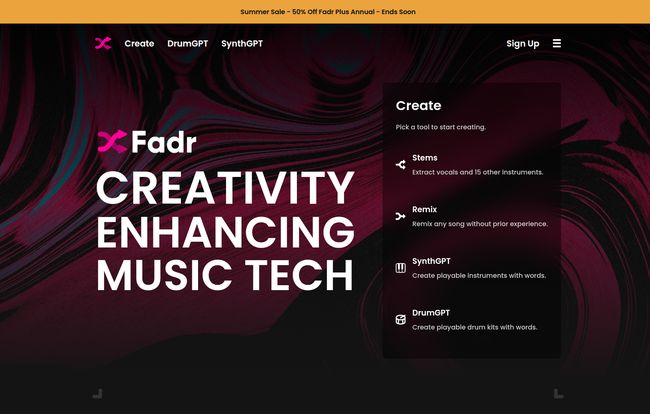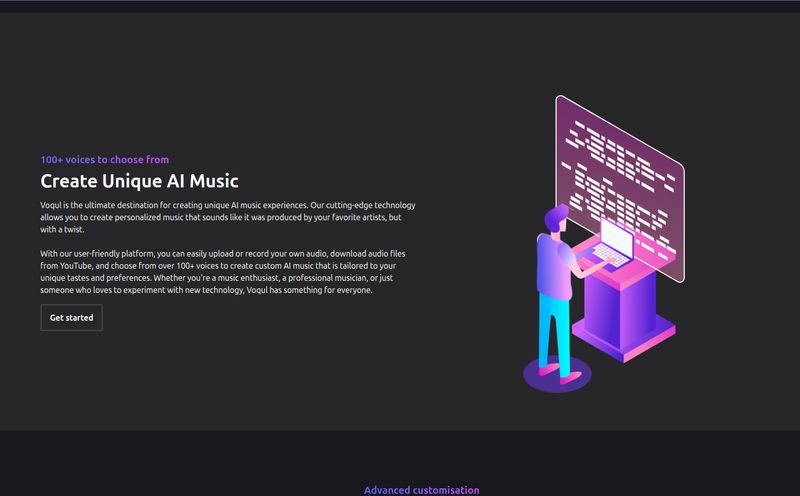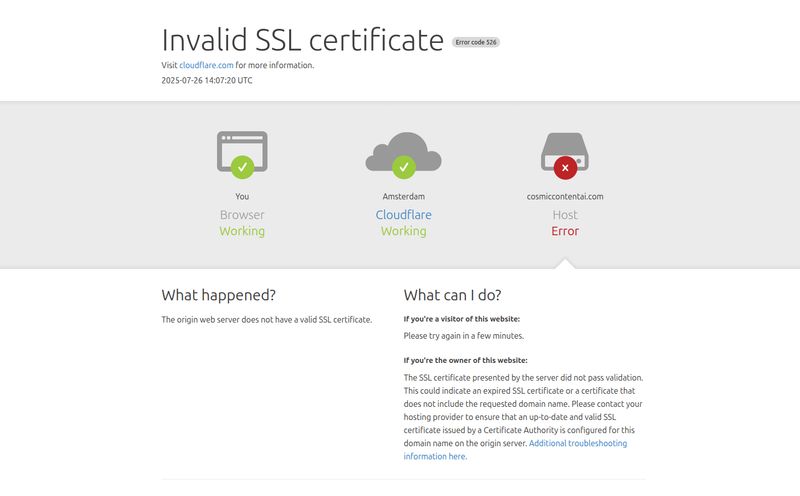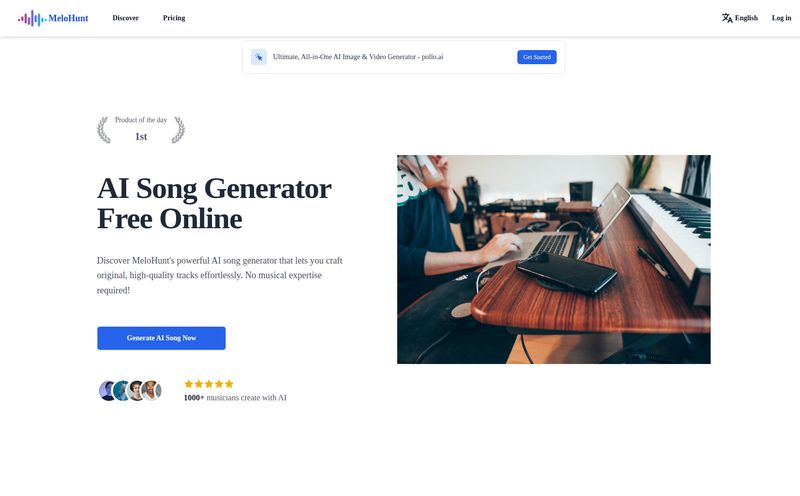If you've been in the music production or DJing game for more than five minutes, you know the struggle. The endless hunt for that perfect, clean acapella. The hours spent trying to isolate a drum break from a dusty funk record using EQ tricks that only sort of work. I’ve spent more nights than I care to admit on sketchy forums, downloading files that promised a clean vocal but delivered a crunchy, artifact-riddled mess. It was a rite of passage, I guess.
But what if I told you that era is… well, over? The tech has caught up. And lately, one name keeps popping up in my circles: Fadr. It bills itself as a suite of AI music tools, and frankly, I was skeptical. We’ve all seen AI tools that promise the world but deliver a toy. So I rolled up my sleeves, grabbed a few tracks, and decided to see if Fadr is just another flash in the pan or if it's genuinely the creative co-pilot we've been waiting for.

Visit Fadr
So, What Exactly Is Fadr?
Think of Fadr as a digital Swiss Army knife for audio. It's a web-based platform that uses artificial intelligence to perform tasks that used to require specialized software, a ton of patience, and a bit of dark magic. At its core, you upload a song, and Fadr's AI gets to work, breaking it down into its core components. We're talking vocals, drums, bass, melodies… all separated and ready for you to play with.
But it doesn't stop there. It’s not just a stem splitter. It’s also a remixer, a mashup engine, a key and tempo detector, and it's even dabbling in a browser-based DJ controller. It’s a whole creative suite packed into a surprisingly clean and simple interface. And the craziest part? A huge chunk of it is completely free.
Breaking Down The Core Fadr Features
Let's get into the meat and potatoes. What can this thing actually do? I’ve messed around with pretty much every corner of the platform, and here's my breakdown.
Stem Separation: The Magic Wand for Audio
This is the headline feature, and for good reason. The ability to pull apart a finished track into its 'stems' is the holy grail for remixers and producers. Fadr lets you upload a song and it spits back separated tracks for vocals, bass, drums, and other instruments. For a free tool, the quality is… shockingly good. Is it flawless? No, you'll still hear some digital 'ghosting' or artifacts, especially on complex tracks. But compared to the phase-inversion tricks we used to pull in Audacity? It's night and day.
For most bedroom producers or DJs looking to create a quick bootleg, the standard MP3 quality from the free version is more than enough to get the job done. It's clean enough for a mixshow or a fun mashup. Honestly, the fact that you can do this unlimited times without paying a dime is wild.
Remix and Mashup on Autopilot?
Once you have your stems, Fadr’s Remix and Mashup features kick in. This is where it gets interesting for DJs. You can take the stems from two different songs and start blending them. The AI helps by automatically detecting the key and tempo and syncing them up. It’s a fantastic way to quickly audition ideas that might have taken an hour to prep in Ableton. You can change the key, adjust the tempo, and create a brand new version of a track on the fly.
Is it going to replace a skilled DJ's ear for phrasing and harmonic mixing? Not yet. But as a tool for rapid-fire creativity and finding those unexpected pairings, it's brilliant. It lowers the bar for entry, which I think is a great thing for music in general.
The “GPT” Plugins: DrumGPT and SynthGPT
Now this is where Fadr steps into the future. They have these plugins called DrumGPT and SynthGPT. The concept is simple and kinda bonkers: you type in words, and it generates sounds. For DrumGPT, you could type “hard-hitting 80s gated reverb snare with a modern kick” and it will generate a drum kit for you. SynthGPT is the same but for synth patches.
This is a sound designer's playground. Instead of endlessly scrolling through presets in a VST, you can just… ask for what you want. The results can be a little unpredictable, which is part of the fun. It’s an incredible source of inspiration when you're feeling stuck. I've already used it to cook up some unique percussion loops I wouldn’t have thought of on my own.
For the Serious Producer: The Stems Plugin and Pro Features
Okay, so what if you're past the hobbyist stage? This is where Fadr Plus comes in. The biggest draw for me is the Stems Plugin. This lets you use Fadr's separation technology directly inside your Digital Audio Workstation (DAW) like Logic Pro or FL Studio. This is a game-changer for workflow. No more exporting from a website and importing into your project. You just drag the plugin onto a track, and it does its thing right there.
Plus subscribers also get higher quality, lossless WAV downloads, which is non-negotiable for professional releases. You also get more granular control, like separating individual drum parts (kick, snare, cymbals) and access to their API if you're a developer. It's a clear step-up for those who need that extra quality and integration.
Fadr Pricing: Is The Upgrade To Plus Worth It?
This is always the big question, right? Fadr has a pretty simple two-tier system, which I appreciate.
- Fadr Basic is Free. And when they say free, they mean it. You get unlimited stems, remixes, and access to the DJ sets with high-quality MP3 downloads. For 90% of casual users, this is more than generous.
- Fadr Plus will set you back $10 a month or $100 for a year. This unlocks all the pro features we just talked about: the invaluable Stems Plugin, lossless WAV downloads, individual drum separation, API access, and more.
Here's my take: if you are a hobbyist, a new DJ, or just someone curious about remixing, stick with the free version. It's powerful enough to let you learn and create without spending a penny. But if you are a professional producer, a working remix artist, or a content creator who needs the absolute best audio quality and a streamlined workflow, the Fadr Plus subscription is a no-brainer. The cost of the Stems Plugin alone is worth the price of admission compared to some standalone competitors.
My Honest Take: The Good and The Not-So-Good
No tool is perfect. After spending a good amount of time with Fadr, I have a pretty clear picture of its strengths and weaknesses.
On the plus side, the sheer value of the free tier is undeniable. It's a powerful, user-friendly platform that democratizes music creation. The AI-powered features like DrumGPT and SynthGPT are genuinely innovative and fun. For me, it's become a go-to tool for quick idea generation and grabbing a vocal stem when I'm in a pinch. It just works.
On the other hand, let's be real. The AI isn't a miracle worker. While the stem separation is great, it’s not always pristine. Purists and audiophiles might find the slight artifacts in the free MP3s a dealbreaker, pushing them towards the paid tier. And some might argue that relying too much on AI tools can stifle the development of core production skills. That's a valid point, but I see it more as a tool to augment creativity, not replace it entirely. Also, some of the beta features can feel a bit, well, beta. But that's to be expected.
Final Verdict: Is Fadr A Must-Have Tool?
So, we circle back to the main question. Is Fadr the future of music production? In some ways, yes. It represents a significant shift in how we can interact with and manipulate audio. It makes complex processes accessible to everyone, and that is something to be excited about.
It's not going to write a hit song for you, and it won't replace the years of practice it takes to become a great producer. But what it will do is remove technical barriers, spark new ideas, and save you a ton of time. It’s a fantastic creative partner. Whether you're a seasoned pro looking for a faster workflow or a complete beginner taking your first steps into remixing, Fadr has something to offer. Given that you can try the best parts for free, there's really no reason not to give it a spin.
Frequently Asked Questions about Fadr
- Is Fadr really free to use?
- Yes, the Fadr Basic plan is completely free and offers unlimited use of its core features like stem separation and remixing, with high-quality MP3 downloads. There's a paid tier, Fadr Plus, for more advanced, professional features.
- How good is Fadr's stem separation quality?
- For a web-based tool, it's excellent. The free MP3s are great for DJing and quick edits. For studio-quality work, the Fadr Plus subscription offers lossless WAV files, which provide a much higher fidelity and are better suited for commercial releases.
- Can I use stems from Fadr in my commercial projects?
- This is a copyright question, not a technical one. Fadr gives you the tool to separate the stems, but you are still responsible for clearing the rights to the original song if you plan to release your remix commercially. For original creations using SynthGPT/DrumGPT, you're generally in the clear.
- What is the main difference between Fadr Basic and Fadr Plus?
- The main differences are audio quality and professional integration. Fadr Plus gives you lossless WAV files, the ability to use the Stems Plugin directly in your DAW, more detailed stem separation (like individual drum parts), and API access.
- How do DrumGPT and SynthGPT work?
- They are text-to-sound AI models. You provide a descriptive text prompt (e.g., “a dreamy, ambient synth pad” or “a tight, funky 70s drum kit”), and the AI generates a unique audio sample or instrument patch based on your description.
References and Sources
For more information, pricing details, and to try the tool yourself, check out the official Fadr website.



